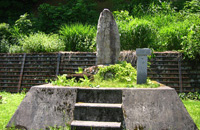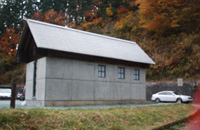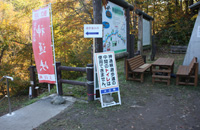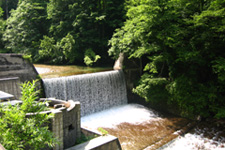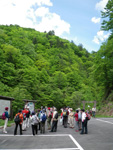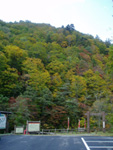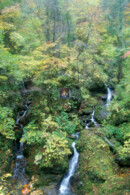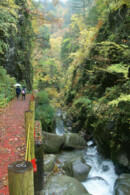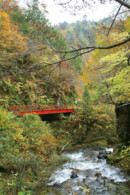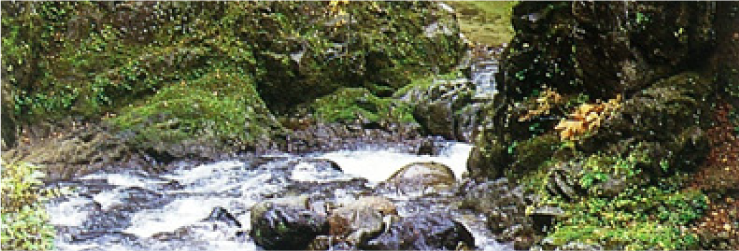
Jintsu-kyo Gorge

Jintsu-kyo Gorge
This is a gorge formed over thousands of years by the water that has been flowing out of approximately 3,000 hectares of mountains including the Asahi Mountain Range and Mt. Koasahidake. It is located in the Yanagawa district on the west side of the town of Oe.
There used to be a rail car line for transporting lumber cut in Kodera to Yanagawa along the gorge a long time ago, and it has been reformed into a trail now for people to enjoy the walk.
The most popular seasons are the end of May to June when fresh green comes out and snow melts away, and the end of October when the foliage changes to autumn colors.
Period: End of May to late November (subject to slight changes depending on the snow condition).
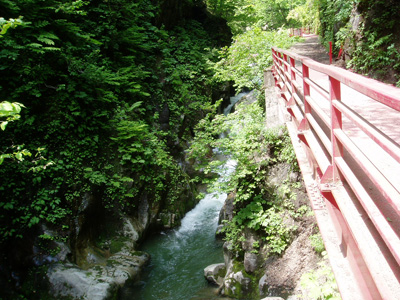
▲Fresh yet deep green of the trees
Jintsu-kyo Gorge in the Season of Fresh Green
Best season: Late May to June
The exceptionally deep hue of the fresh green filled with youthfulness coupled with the scenic river reflecting the warm sunlight of new spring filtering through foliage creates a wonderful atmosphere.
Enjoy the refreshing air and the lively Jintsu-kyo Gorge in spring.
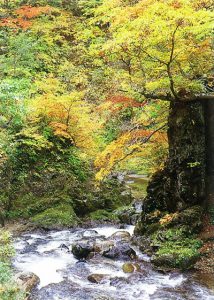
▲Trees turning their leaves into autumnal colors of yellow, orange, and red
Jintsu-kyo Gorge in Autumn Foliage
Best season: Late October to early November
Flamboyant colors of autumn foliage in yellow, orange, and red are reflected on the surface of the river which is as scenic as it is in spring, displaying the exceptional feel of the season.
The brilliant beauty of the autumn foliage awaiting the coming of severe winter is nothing but a work of art.
Enjoy the life-kindling autumnal Jintsu-kyo Gorge, exhibiting the awe-inspiring contrast of colored leaves.

Description of the Site
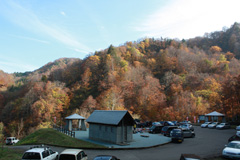
▲Takimae Mountain Village Park
(1) Takimae Hiroba Park
The trailhead is located on the Yanagawa side. The park is equipped with a parking space that can accommodate approximately 30 cars, two arbors for resting, a memorial service pagoda for trees and plants, and a public restroom. Descend the stairs next to the arbor in the back to find the trailhead. Note that the only restrooms on the trail are located here and at the Green Space Rest Center, so it is highly recommended to use the toilet here before you start trekking. (The Kodera erosion control dam parking space also has a portable toilet.) Also, be aware that the road is not wide enough for large-sized buses to come through. Those who plan to visit the trail on a large-sized bus are kindly requested to park at the Kodera Green Space Rest Center. Also be aware that water provided from faucets in the park is not drinkable.
(2) Suspension Bridge
Descending from Takimae Hiroba to the riverside, there is a suspension bridge. The Tsukinuno River that runs along the Jintsu-kyo Gorge can be viewed closely from this bridge. Note that the trail ends after crossing the bridge, so the bridge is just for enjoying the view of the river.
(3) Takimae Trailhead
There is a 4.2-km long trail between Takimae Hiroba parking space in Yanagawa to Kodera erosion control dam parking space for an easy stroll.
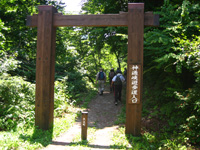
▲Trail entrance at Jintsu-kyo Gorge Takimae Hiroba
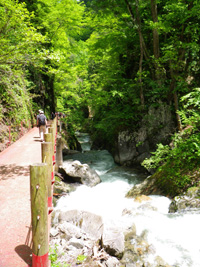
▲View of Jintsu-kyo Gorge
(4) Trail
Fudo Myo-o (fierce Buddhist deity) & Jintsu-kyo Gorge Bridge: This is the best part of the trail. A narrow, precipitous valley, a huge rock that has seen many years, and the vigorous flow of the clear Tsukinuno River that runs through the valley form a beautiful sight together.
It is especially refreshing in June, the season of fresh green, when water is abundant. This could be a good spot to set as a trekking goal.
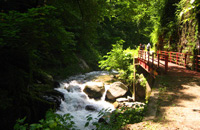
▲Jintsu-kyo Gorge Trail
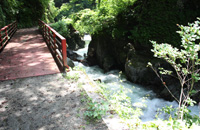
▲Jintsu-kyo Gorge Bridge
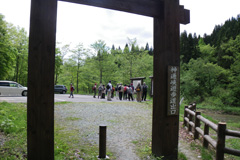
▲Trailhead on the Kodera side
(5) Kodera Erosion Control Dam Parking Space
The trailhead is on the Kodera side. There is a parking space for approximately 15 cars. Enter the parking space, and you will find the trailhead just in front. Note that the road is not wide enough for large-sized buses to come through. Those who plan to visit the trail on a large-sized bus are kindly requested to park at the Kodera Green Space Rest Center.
Also, since there is no restroom (except for one portable toilet), using the toilet at the Kodera Green Space Rest Center just before here is strongly recommended.
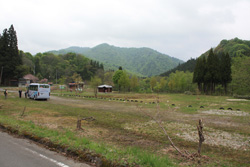
▲Kodera Green Space Rest Center
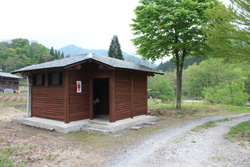
▲Restroom at Kodera Green Space Rest Center
(6) Kodera Green Space Rest Center
This park is located in a temple village. It has a camping ground, sanitary house, and a restroom. Those who came to Jintsu-kyo Gorge on a large-sized bus are kindly asked to park their vehicle here. Also, because there are no other restrooms in the vicinity (except for the portable one at the Kodera erosion control dam parking space), it is highly recommended to use the one in here before you start trekking.
Waterworks at the Kodera Green Space Rest Center are currently out of order.
We apologize for the inconvenience and appreciate your understanding.
The Origin of the Name of Jintsu-kyo Gorge
The Jintsu-kyo Gorge is located at the midpoint between Yanagawa and Kodera, where a mountain stream runs, breaking against giant rocks and precipices for approximately 4 km.
In 1954, when Hongo Village and Shichiken Village were merged to newly form Urushikawa Village, Tokichi Abiko, the governor of Yamagata Prefecture at the time went searching for the significance of Urushikawa and the old ruins of Kodera Sengen-ji Temple, and named the gorge “Jintsu-kyo (Jintsu-kyo Gorge)” quoting from a verse in an old Chinese poem.
(The source of the quote is as follows.)
Source
Hokekyo Kannon
Fumonhon ni iwaku
Gusoku Jintsu riki
Koushuchi houbin
Jippo Shokokudo
Musetsu fugenshin
Japanese Translation
Fully utilize the divine power (Power of Jintsu), widely pursue wisdom and the means, and Kannon will appear in every place and all directions of this land.
Derivation
There is an old ruin of Kodera Sengen-ji Temple on the upper stream of the Urushikawa River. The name of Sengen derives from the Kannon of great compassion and mercy. The divine power of the deity symbolizes its capability to always reach every piece of land in every moment. The great benefit contained within the Urushikawa River will transform into the infinite divine power through our development. This area also has a stream that leads to the eternal snow of the sacred mountains of Asahi (Kodera River and Tsukinuno River). Anything and anyone derived from this stream are equally the incarnation of this divine power. Therefore, you should properly put your minds together and respect yourselves.




